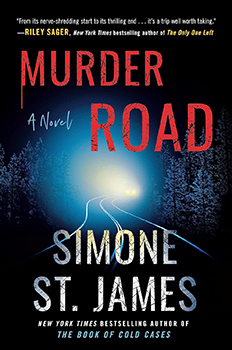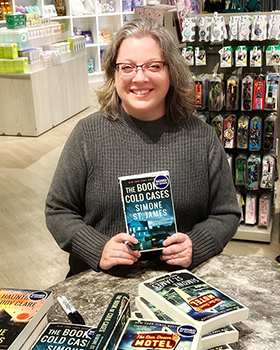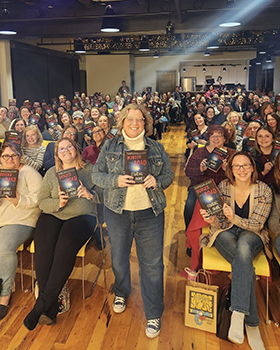

Features Simone St. James
THE INTERSECTION OF SUSPENSE AND THE SUPERNATURAL
The Big Thrill Interviews Bestselling Author Simone St. James
It’s the title that never was but could have been. Luckily for readers (and for her!), New York Times bestselling author Simone St. James left a 20-year career in television budgeting to pursue writing full-time before she met an Excel-erated demise. This was no overnight decision but a calculated risk. After having spent countless evenings over many years moonlighting as an aspiring novelist, St. James began to submit her work. Her eventual debut came with 2012’s The Haunting of Maddy Clare, which introduced her signature melding of suspense with supernatural elements; that book would go on to win two RITA Awards as well as an Arthur Ellis Award from Canada’s Crime Writers. Eight novels followed, including The Sun Down Motel and The Book of Cold Cases.
This March, St. James returned with a new standalone, MURDER ROAD, in which a wrong turn has deadly consequences. It’s July 1995, and newlyweds April and Eddy are on their way to their honeymoon destination when they accidentally find themselves driving Coldlake Falls’ Atticus Line. It’s dark and desolate—and yet their headlights illuminate a young woman staggering down the road who appears in need of help. After reluctantly accepting a ride, she falls unconscious in the backseat, with April soon discovering that her torso, obscured under an oversized coat, is bloodied from stab wounds. They rush her to the local emergency room, where she succumbs to her injuries—and April and Eddy find themselves suspects in her death.
Unable to leave town for a multitude of reasons, April and Eddy—in some ways, still strangers to one another despite their marriage—vow to clear their names and get justice. But their investigation soon reveals that Atticus Line has been the scene of several unsolved murders over the last few decades, all of which seem somehow related to the local legend of The Lost Lady, whose remains were discovered in 1976 but never identified. Could she be exacting vengeance from beyond the grave, making this lonely stretch of road her killing ground? Finding out will be a matter of life and (more) death.
Now, Simone St. James invites us to navigate MURDER ROAD…
MURDER ROAD centers on a desolate stretch of street that’s been the site of several unsolved murders over a span of decades. What appealed to you about this premise, and was it inspired by any of the real-life cases of killing grounds that have made headlines in recent years?
Atticus Line (the road in the novel) wasn’t inspired by any real-life cases. It’s more of an exploration of the idea of urban legends, their durability, the way they often continue from one generation to the next. I didn’t use any details of real-life cases because I prefer to make up my cases from scratch.
Your main characters, April and Eddy, are young newlyweds whose honeymoon is waylaid by suspicions of murder. In what ways do these circumstances influence the dynamic between them, and how is this further exacerbated by the realization that each is keeping secrets from the other that threaten to spill out?
Since April and Eddie are just married, they are in love, and they know each other—but they don’t know absolutely everything about each other yet. They get to know each other more deeply at the same time the reader gets to know them. They also have to rely on each other in life-or-death situations and trust each other in the deepest way. It heightens the tension between them at the same time they are dealing with tense external threats.
Eddy is a war veteran who suffers from PTSD. What was your approach to rendering this condition with authenticity and sensitivity, and how does the affliction impact both how Eddy sometimes sees things and how he is sometimes seen by others?
I have portrayed PTSD in many of my books, starting with the books I wrote that are set just after World War I. Eddie is the first character I’ve written with PTSD from one of our modern wars. I write about PTSD because I simply think it isn’t talked about enough or portrayed in art with enough empathy. Eddie can’t always trust his own perceptions or his own senses, which means April has to learn when he is seeing things and when he isn’t. It adds to the intimacy of their relationship while at the same time making Eddie something of an unreliable witness.
April and Eddy make the decision to investigate the murders and local legend of the “Lost Girl.” What factors help to legitimize their continued involvement despite the potential consequences of doing so, and how does their relationship with local law enforcement play into this?
Well, April and Eddie do try to leave town! I won’t spoil what turns them back, but they realize there may be a reason they’re still there. They’re also trying to do the right thing, and leaving murders unsolved feels wrong to them. They’re playing something of a cat-and-mouse game with the local police, trying to help while keeping secret certain things about their pasts. It’s a tricky game.
Speaking of the “Lost Girl,” tell us what fascinates you about the supernatural. How do you endeavor to balance the concrete world with otherworldly elements while maintaining an overall sense of realism?
Adding a supernatural element to my stories adds extra danger and heightened stakes for the characters. It adds unpredictability since the reader doesn’t quite know how it’s going to go. The supernatural elements always complement the real-world story and highlight certain elements of it. Plus, it’s very fun to write because I get to leave reality behind for that part of the story.
The story is set in 1995—a time when much of today’s technology was in its infancy (if existent at all). In what ways did this era lend itself to the story you wanted to tell? Also, tell us about your approach to capturing the essence of that time period without getting heavy-handed with overly specific details/references.
Writing in the pre-internet era means that your characters can get truly lost, like April and Eddie are in the first chapter of the book. It means your characters can vanish completely. It heightens the mystery and adds danger to your characters’ situation when they can’t simply call each other or call for help. The details of 1995 come straight from my memory, which is why they feel real and not added in. I didn’t simply add music and movie references, but what we wore, what we ate, what things cost, and how we got around.
The book is brimming with memorable secondary characters—Rose, the Snell sisters, and Detective Quentin, among them. How do you ensure that such peripheral characters come across as multidimensional despite their limited presence? Did you find yourself particularly taken with any of them as the story developed? (If so, who and why?)
My secondary characters regularly declare when they are not ready to leave the story. Rose is a perfect example. As the owner of the B and B April and Eddie are staying in, she was supposed to be a one-line character. But once she appeared, I wondered what her story was. I also thought that a woman who owns a local B and B would know a lot of local gossip. So, Rose hung around, and it turned out she had a lot to say. I don’t calculate these things; they happen.
You spent two decades working behind the scenes in television before pursuing writing full-time. How does being a novelist satisfy you in ways that your earlier career(s) didn’t?
My job was in budgets, making Excel spreadsheets. In the evenings, I would go home and write my novels—I did that for years before I finished anything publishable and sent it in. To say that being a novelist is more satisfying is an understatement. I have no desire to look at another spreadsheet ever again!
The Big Thrill Interviews Bestselling Author Simone St. James
- Maureen Johnson by John Valeri (VIDEO) - November 15, 2024
- Elle Marr - August 1, 2024
- C.J. Tudor - April 25, 2024




